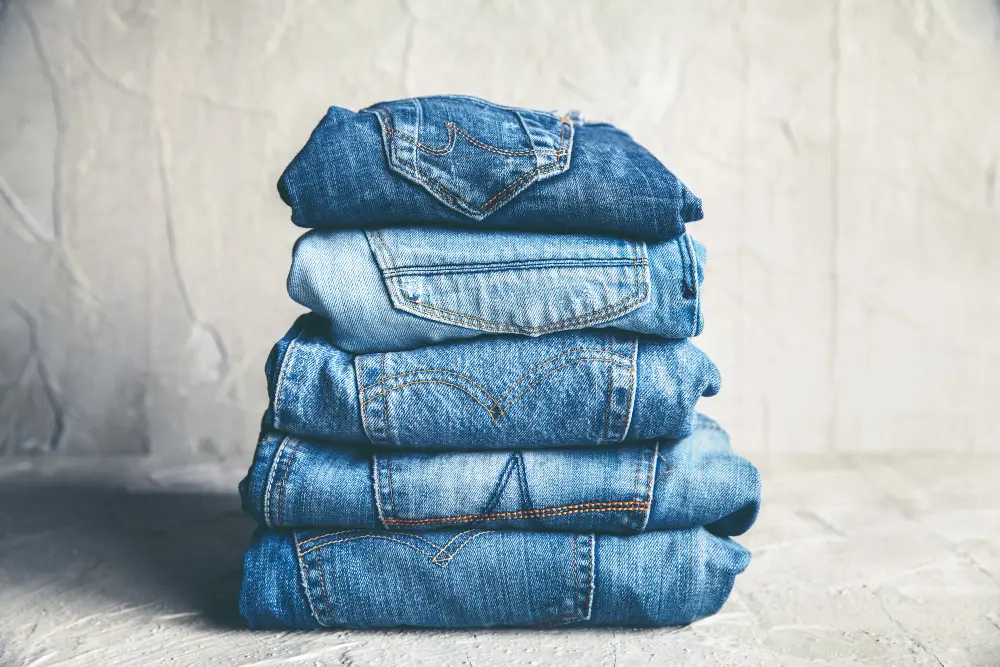
Denim, a versatile and long-lasting fabric, is prominent in fashion and everyday wear worldwide. It is known for its durability and timeless appeal; it is used in various garments, from jeans and jackets to skirts and shirts.
The global market value for denim fabric used in jeans is expected to increase to about USD 23.86 billion between 2024 and 2028. This growth means the market is expanding at an annual rate of about 6.64%. This growth shows that this fabric remains a favorite choice for clothing, promising to stay fashionable in the future.
Table of Contents
What is Denim Fabric?
Denim is a flexible cotton fabric with a distinctive diagonal ribbing pattern achieved through a twill weave. This weave structure positions the warp yarns predominantly on the fabric’s face, with the weft threads passing under two or more warp threads. This twill construction distinguishes denim from similarly robust woven cotton fabrics like canvas or cotton duck, emphasizing its unique diagonal texture.
History of Denim Fabric
The origins of Denim Jeans have separate historical roots. The term “jeans” originated in the 1560s from the French word “gênes” or “genes,” used to describe sturdy twill trousers worn by sailors from Genoa, Italy. “Denim” stems from Nîmes, France, where “serge de Nîmes,” a robust cotton twill initially made with wool and silk, evolved into the fabric we know today.
The modern understanding of denim emerged in 1860 when Levi Strauss & Co., known for its canvas work pants, introduced denim apparel to cater to customers seeking a softer, more comfortable fabric. In 1873, Levi Strauss and Jacob Davis patented riveted work pants, integrating denim, which became ubiquitous in farm and industrial wear well into the 20th century, solidifying its status as a staple in American workwear and beyond.
Uses of Denim Fabric
Denim jeans fabric is a versatile and durable material that finds various applications across various domains. Its rugged texture and timeless appeal make it a popular choice for fashion and functional items. Here are some of the common uses of this fabric:
Apparel: Most fabric is used for jeans, skirts, shirts, blouses, jackets, and vests.
Accessories: Commonly used in shoes, belts, purses, and hats.
Homewares: Used in drapes, upholstery, blankets, duvets, and pillows.
Different Types of Denim Fabric
Denimwear comes in various types from jeans manufacturers in Bangladesh, each with distinct characteristics and uses. These differences can impact the fabric’s texture, durability, and appearance, catering to various fashion needs and personal preferences. Here’s a rundown of the different types of fabric:
Raw Denim
Raw denim is untreated and unwashed fabric. It retains its original, stiff texture and dark indigo color. Many wear the raw type for several months to a year without washing it.
Sanforized Denim
Sanforized denim undergoes a process to reduce shrinkage before it reaches the consumer. This treatment involves washing the fabric, which makes it softer and more comfortable to wear immediately.
Stretch Denim
Stretch denimwear combines cotton with elastic materials like spandex or elastane. This blend provides added flexibility and comfort, making the fabric ideal for form-fitting clothing such as skinny jeans and jeggings.
Crushed Denim
Crushed denim features a unique texture achieved by weaving the fabric to give it a permanently wrinkled or crushed appearance. This texture is reminiscent of velvet, offering a visually appealing and stylish look.
Selvedge Denim
Selvedge (or selvage) denim is characterized by its self-finished edges, which prevent the fabric from unraveling. This type is produced using traditional shuttle looms, creating a tightly woven fabric with a clean edge. The selvedge is usually visible on the inner seams of jeans and is often marked by a colored thread.
Acid Wash Denim
Acid wash denim features a distinctive mottled or marbled appearance when the fabric is washed with a strong acid or bleach solution. This process partially removes the dye, leaving lighter, random patterns on the fabric.
Poly Denim
Poly denim is a blend of cotton and synthetic fibers such as polyester, lyocell, or nylon. This combination enhances the fabric’s durability, wrinkle resistance, and ease of care.
How is Denim Fabric Made?
Denim jeans made in Bangladesh, known for their durability and distinctive texture, undergo a detailed production process from the farm to the final product. This journey begins with the cultivation of cotton and ends with the weaving of the fabric, ready to be transformed into various products.
Cotton Cultivation: The process starts with growing cotton, which produces fibers around its seeds.
Processing into Yarn: The fibers are cleaned, combed, and spun into yarn. Various treatments may be applied.
Final Production: The dyed yarn is woven into denim fabric and sold in bolts by the yard for making products.
The Bottom Line
Denim’s legacy as a fabric of choice spans centuries and continents, embodying tradition and innovation. Its ability to transcend generations and cultures ensures its place as a cornerstone of modern style. As trends come and go, jeanswear remains a timeless canvas for personal expression, inspiring and enduring.


